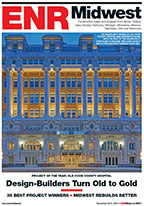...construction companies, as well as industry associations, Midwest Construction found most agree the recovery will come gradually.
Ed Sullivan, chief economist of the Portland Cement Association in Skokie, Ill., believes 2010 will see small growth in cement use, and that 2011 and the years after will be better for cement producers.
Says Sullivan, “Conditions facing the construction industry are likely to remain weak for another year or more, causing a drag on cement consumption. A modest 5% increase will materialize in 2010, with significant growth in consumption expected for 2011 and beyond.”
Sullivan says any near-term turn in overall activity will be dictated by public construction, but he notes that 33 states have severe deficits for fiscal 2010. One bright spot: he expects ARRA highway projects to use more than five million tons of cement in 2010 and 2011.
Robert Krier, President of Hill Mechanical Group, Franklin Park, Ill., expects 2010 to be a slow year for the industry. “I believe the current downturn will bottom out in 2010, and that the industry will stay flat or grow slowly for five to 10 years after,” he says. “The industry’s whole cycle has to be re-set by a correction in the excess of commercial real estate over the next year. Then the cycle will start over.”
Krier also notes that the lack of work and tight lending criteria will extend the pain now felt by small contractors to larger ones. “I would not be surprised to see some heavily leveraged large contractors go out of business,” he says.
Fortunately, says Krier, Hill Mechanical is free of long-term debt and expects to weather the downturn by expanding the variety of services it offers, by taking advantage of the opportunity to buy commodities at lower prices, by improving efficiency, and by getting even better at using BIM and integrated project delivery.
“Even though our construction revenue has dropped $100 million this year,” says Krier. “We are still strong. One reason is that we’ve expanded the services we offer to include vibration testing and balancing, infrared scanning, and retro-commissioning of building mechanical systems. We’re also expanding our involvement with a building’s mechanical systems throughout its lifetime. We work on the design, construction, installation, servicing, and operation. Some of our clients even have Hill employees as their mechanical system operators.”
Bill Browne, Jr., principal and president of Ratio Architects, Indianapolis, says this is the fourth, and worst, recession he has faced since starting the company in 1982.
Browne says Ratio has weathered the downturn well but expects 2010 to be slower than 2009. He is approaching the new year with guarded optimism after seeing a rise in inquiries from potential customers in recent months. Still, he expects this recovery to be slow and flat.
“If bankers start lending,” he says, “things will be better. Money needs to be released responsibly, but right now even projects that seem good and responsible are having trouble getting financing.”
Browne sees institutional, public, healthcare, and higher education as the strongest sectors in 2010. “Universities...



Post a comment to this article
Report Abusive Comment